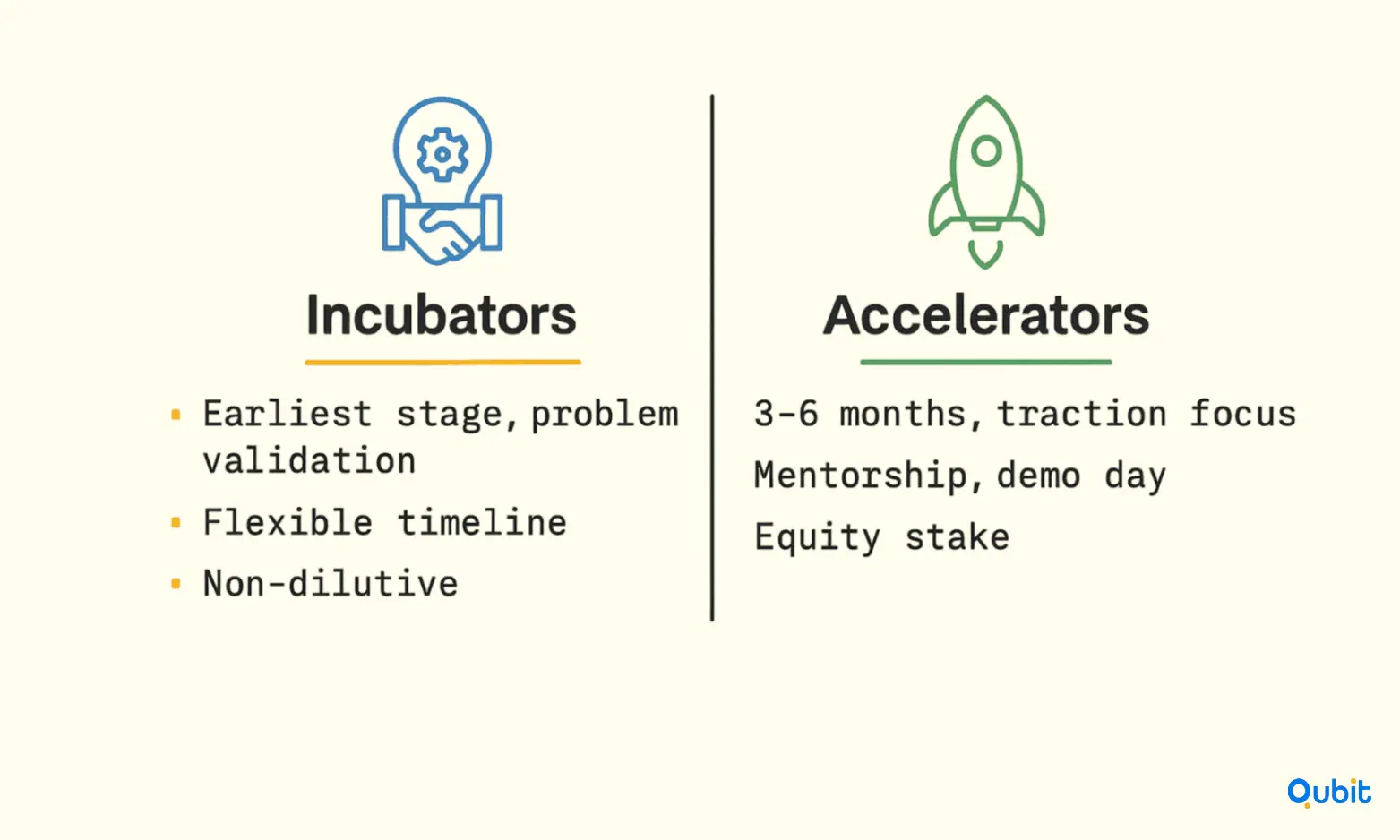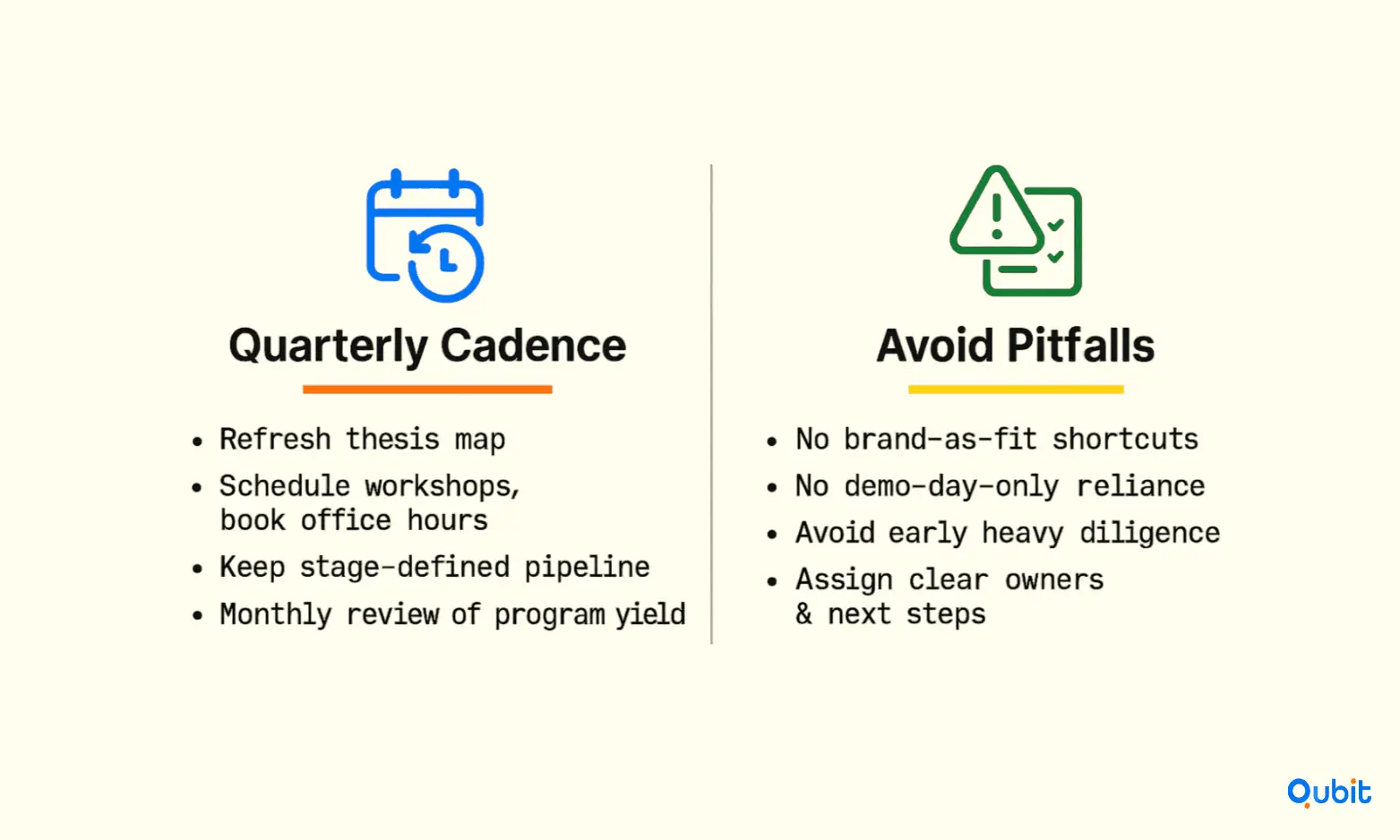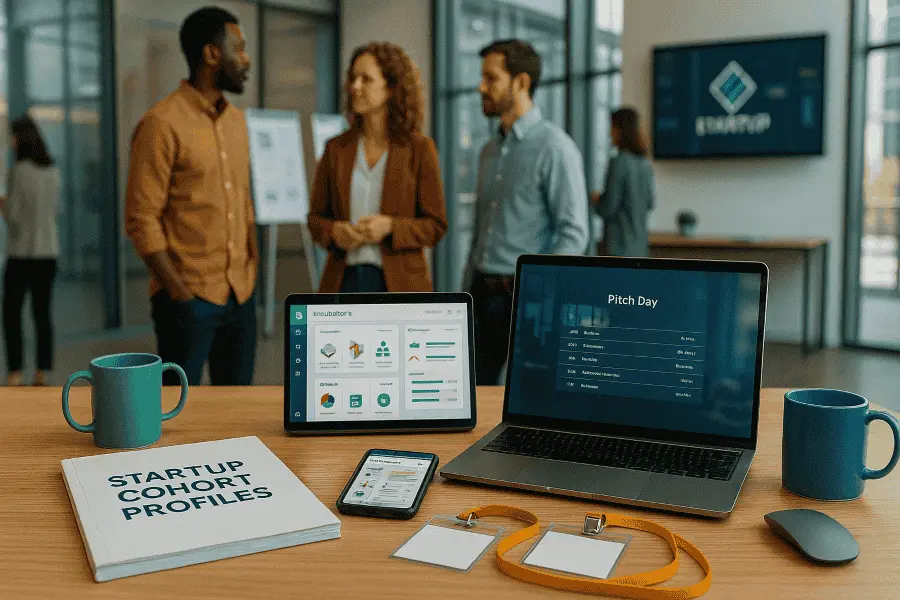Investors who consistently source high-quality founders from incubators and accelerators don’t just show up on demo day, they build relationships with program managers, map their thesis to specific programs, and run a disciplined triage and follow-up process that converts signal into meetings and diligence. Your investment approach gains broader context through insights on how to do startup outreach for investors, which align with the wider tactics used in startup outreach.
This guide explains how incubators and accelerators differ, how to target the right programs, what to watch for in cohorts and demo days, how to run fast follow-ups, and how to measure ROI from this channel across a quarter.
Understanding the Differences: Incubators vs. Accelerators
While both serve as founder support systems, there are key differences that affect how investors should approach them:

- Incubators focus on the earliest stages, sometimes even before a product exists. They emphasize problem validation, early product development, and business model shaping over a flexible timeline. Funding is less common, and the model may be non-dilutive.
- Accelerators are structured and time-bound, typically 3–6 months. They admit teams with a product and some traction, deliver intensive mentorship, and typically end in a demo day or investor showcase. Many also invest a small seed amount in exchange for equity.
Practical implication: Investors seeking earlier discovery of technical or research-driven teams will benefit from incubator relationships, while those focused on ready-to-scale companies should prioritize accelerator cohorts and demo-day funnels.
Targeting the Right Programs
The highest ROI comes from aligning a thesis with the right programs by stage, sector, and geography. Build a short list of 10–20 programs that repeatedly graduate on-thesis companies and maintain a consistent cadence of communication with their directors. Prioritize:
- Sector-aligned accelerators (e.g., fintech, healthtech, climate) whose programming and mentors match the buyers and regulatory realities of the thesis.
- Regionally strong ecosystems (e.g., Europe via Dealroom-tracked hubs) where accelerators partner with corporates and public bodies for pilot access and market entry.
- University-linked incubators and corporate incubators that mature research-to-venture commercialization or spin-outs, often with distinct IP and regulatory depth.
| Criteria | Example Questions to Ask |
|---|---|
| Stage Fit | “Does this program recruit teams pre-product or post-revenue?” |
| Sector Alignment | “What share of your cohorts matches my investment thesis?” |
| Geographic Reach | “Where do most founders you serve operate?” |
| Alumni Outcomes | “How many portfolio companies closed significant rounds post-program?” |
| Post-Program Value | “Do you maintain an alumni network with ongoing investor introductions?” |
A working map should cover stage fit (incubator vs. accelerator), program length/cadence (rolling vs. 3–6 months), funding model (equity vs. fee vs. non-dilutive), demo-day format (in-person vs. virtual), and post-program alumni engagement (introductions, office hours, partner showcases). For instance, a review of startup databases naturally includes investor tips for startup demo days, which enriches the narrative with practical examples from industry events.
Building Relationships with Program Teams
Program managers and EIRs are critical partners: they know which teams are execution-ready, which need time, and which are quietly outperforming. Offer specific value that aligns with your thesis:
- Host short workshops on pricing, enterprise security posture, or pilot-to-paid conversions (aligned to your sectors).
- Volunteer for targeted office hours before demo day (screened for your thesis fit) to help founders problem-solve and to identify high-signal teams early.
- Share a transparent “what we invest in” rubric, stage, check size, reserves, buyer context, so program staff route the right founders your way.
This “give first” posture compounds trust and ensures your outreach after demo day is welcomed rather than generic.
How Programs Select Startups (and Why That Matters)
Understanding selection criteria helps predict cohort quality and match diligence to program signals. Common filters include business model viability (credible path to revenue), uniqueness of product/insight, team capability, and market demand, assessed through applications, interviews, and due diligence stages.
Accelerators also optimize for scalability and speed, given the short program timeline. This means accelerator cohorts tend to have clearer GTM hypotheses and early traction, while incubator-backed founders may have deeper technical novelty but need more time on customer development.
Engaging During the Program
Many investors overlook mid-program engagement opportunities, which can deliver higher ROI than demo day alone.
Useful touchpoints:
- Private mid-program check-ins: Invite selected founders for informal 1:1s to discuss progress and challenges
- Thematic pitch sessions: Participate in smaller, sector-themed pitch nights or workshops
- Beta customer connections: Offer introductions to potential customers in your network while the founder is refining their GTM motion
Direct involvement helps you assess execution quality and market feedback in real time, not just through a polished final pitch.
Engage Mid-Program Where Learning Is Highest
The highest-fidelity signals appear during the messy middle of a program, not at polished endpoints. Join mentor sessions and office hours to watch how teams frame problems, handle objections, and prioritize tradeoffs. Short, structured 1:1s—10 to 15 minutes with a clear prompt—reveal whether founders are learning from customer conversations, converging on a wedge, and sequencing milestones realistically. Offering a single design-partner intro or a lightweight compliance checklist at this stage provides practical value and creates a natural reason to check back in two weeks, turning casual interest into a momentum thread grounded in progress rather than pitch polish.
Use Cohort Pipelines and Alumni Networks as Persistent Deal Flow
Think beyond a single batch. Maintain a living tracker of current cohorts and alumni by program, tagged by sector, stage, geography, and buyer context, with short notes on traction and next catalysts. Revisit this tracker monthly to identify companies that have crossed from “too early” to “on-thesis now.” Alumni ecosystems are especially strong sources of second looks and quiet risers who skipped demo day or matured post-program. A recurring office-hours slot for alumni, narrowly scoped to the thesis, keeps a steady stream of relevant founders in view without event-driven spikes.
Treat Demo Day as a Triage Moment, Not the Strategy
Demo day is useful, but it isn’t the strategy. Arrive with a pre-sorted shortlist and a simple, consistent rubric for fit and urgency so follow-ups are decisive and respectful. The real edge is the groundwork laid before the event and the disciplined follow-through after it. Keep asks small and specific in the first 24 hours, one artifact or a 15–20 minute call with a named objective, so founders can respond quickly while handling broader interest.
Calibrate Diligence to Program Rigor and Segment Reality
Programs vary widely in screening depth and mentor quality; adjust the evidence bar accordingly. University-linked incubators and corporate accelerators often have stronger technical or regulatory scaffolding but slower commercial cycles; sector-specialist accelerators may show faster GTM proof with clearer access to buyers.
In regulated markets, diligence should focus early on validation pathways, standards participation, and procurement hurdles; in workflow SaaS, prioritize proof of repeatable adoption and clear time-to-value in the buyer’s process. Align what is asked and when to the program’s context so diligence is efficient and fair.
Operationalize Follow-Through Across a Quarter
Sustained results come from an operating cadence, not heroics. Set a quarterly plan: refresh the thesis-program map, schedule targeted workshops, book mid-program office hours with two priority accelerators, and block post-cohort review windows.
Keep a simple, stage-defined pipeline for program-sourced companies with owners and SLAs so promising threads don’t die in private inboxes. Review performance monthly: which programs consistently yield on-thesis conversations, which offers (workshops, intros, checklists) generate the best founder engagement, and where to deepen or step back next quarter.

What To Avoid
Common failure modes are predictable: treating program brands as proxies for fit; relying on demo day to do the work of relationship building; asking for heavy diligence artifacts too early; and letting interest cool because there is no owner or time-boxed next step. Each of these erodes credibility and reduces the likelihood of competitive allocations when the company raises.
Case study 1: Corporate pilot accelerator → paid pilots that shorten validation
A corporate-run accelerator model designed explicitly around executing paid pilots helped participating startups secure real customer validation during the program, compressing the time from introduction to pilot, and building credibility that translated into faster fundraising and commercial traction post-program.
The program design began with the corporate’s specific problem statements, matched startups to those needs, and then resourced the pilots so both sides had clear success criteria, making the accelerator a high-signal sourcing channel for investors looking for proof of product-market fit and enterprise readiness.
Investor takeaway: Corporate pilot accelerators can be superior sources of investable teams when the goal is near-term commercial evidence; look for programs that commit to scoped, resourced pilots with defined outcomes rather than generic mentorship tracks.
Case study 2: University incubator and spinout ecosystem → more spinouts and higher-quality pipelines
University spinout ecosystems that combine incubators with dedicated spinout funds have materially increased the volume and quality of investable companies, with one example showing a rise from roughly four spinouts per year to around 20 per year after the creation of a university-backed fund, alongside multiple exits and public listings (including a multibillion-pound IPO).
University incubators underlying this model report significant revenue and capital raised by incubated companies, with a growing share of investment flowing to research-based spinouts once the dedicated fund launched—creating a more consistent, thesis-aligned pipeline for specialist investors.
Investor takeaway: University-linked incubators paired with spinout funds are productive, year-round sourcing grounds for deep-tech and research-led ventures; build relationships with tech-transfer teams and incubator leads to access pipelines before companies enter broad fundraising.
Conclusion
Finding promising startups through incubators and accelerators is a year‑round, relationship-driven motion: target programs that align with your thesis, engage mid‑program where learning velocity is visible, maintain an alumni tracker to catch “now ready” windows, and calibrate diligence to each program’s rigor and segment realities so you convert signal into timely, high‑quality allocations.
Now is the time to act on these insights. If you're looking to secure the right investors, our Investor Outreach service at Qubit Capital can connect you with promising leads. Let’s take your demo day strategy to the next level.
Key Takeaways
- Target programs by thesis, buyer context, and alumni outcomes—not brand alone.
- Build real relationships with program staff through specific, founder-helpful offers.
- Engage mid-program to observe learning velocity and wedge formation.
- Maintain a living tracker for cohorts and alumni to catch “now ready” windows.
- Treat demo day as triage; the edge is pre-work and disciplined follow-up.
Frequently asked Questions
What’s the key difference between incubators and accelerators for investors to consider?
Incubators nurture earlier, often pre‑product teams over flexible timelines, while accelerators are cohort‑based (typically 3–6 months) for product‑ready startups aiming to scale and fundraise, so investors should map programs to stage fit before committing time.






